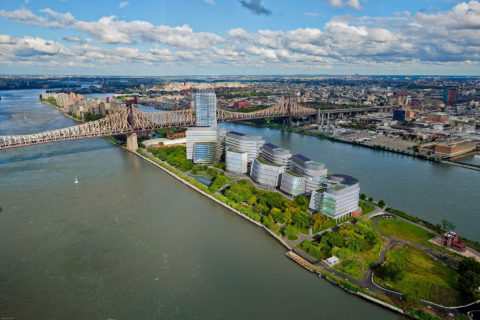
StanfordNYC
This design for a new, sustainable, state-of-the-art applied sciences campus on Roosevelt Island reflects the cross-disciplinary ethos of Stanford’s unique community of thinkers and entrepreneurs addresses the University’s programmatic requirements and pedagogical intentions and creates a memorable sense of place.
Challenges and Opportunities
Responding to the Bloomberg administration’s economic development team’s request for proposal, this master plan offers a solution for how to integrate a 1.87 Million SF cutting edge, unified campus for Stanford University into New York City. From multiple sites across New York City, Roosevelt Island was chosen as the site of new technology incubator. Similar to Stanford’s Palo Alto campus, Roosevelt island is sited between zones of development and venture capital.
Predicated on the dissolution of the traditional purity of academic disciplines and on the corresponding notion that discovery and innovation occur across what once had been boundaries, the integrated architecture and landscape strategy for the Roosevelt Island campus creates places for “productive collisions” among Stanford’s innovators.
Approach
The campus is conceived as a series of translational strands – buildings, esplanades, promenades, courtyards, green roofs – that are organized by building program and support the essential activities of exploration and innovation: research, teaching, living, playing, creating. As they intertwine, intersect, and interact, the strands reinforce and enrich one another, creating a new physical model in which scholarship and entrepreneurship can thrive.
Referencing the Manhattan city grid across the river, these “strands” are segmented and reoriented to maximize access to daylight, solar orientation, circulation, and entrance points. These segments are then joined by a continuous campus connector called “the River”.
Each architectural strand represents an element of the campus program, e.g. laboratory, office / amenity, faculty and student housing and incubator. In the interstices created by intertwining strands are both indoor atria and outdoor spaces of various sizes and types.
Outcomes
The restored wetlands form the centerpiece of the campus quad and return the island to its natural state. Each program retains autonomy and connection to each other through shared atria and greenspace.
The scale and density of the campus take their cues from Roosevelt Island and the dense urban fabric of the surrounding New York City boroughs, and the massing is directed toward maximizing daylighting, natural ventilation, and reducing solar heat gain.
Details
- Year
- 2011
- Location
- New York, NY
- Size
- 1,875,000 GSF
- Program
- Laboratories, Offices, Faculty and Student Housing and Amenities, Incubator Space
Team
- Ennead Design Team
- Richard Olcott, Timothy Hartung, Molly McGowan, Amina Blacksher, Christina Ciardullo, Aimee St. Germain, Yu Inamoto, Christopher James, Wanlika Kaewkamchand, Kate Mann, Brian Masuda, Lois Mate, Alex O'Briant, Jarrett Pelletier, Jacob Reidel, Yong Roh, Melissa Sarko
Press
- 2011
- Lapin, Lisa. “Stanford submits plans for applied sciences and engineering campus in New York City” (stanford.edu, 11/26/2011)























